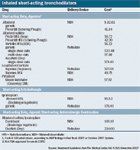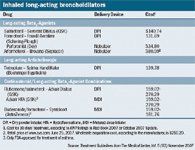Bronchodilators can be effective in reducing COPD symptoms
In chronic obstructive pulmonary disease (COPD), airways in the lung are partially obstructed. It's often a mixture of two diseases, chronic bronchitis and emphysema. The condition is marked by a progressive decline in lung function.

Cigarette smoking is the cause of 85% of COPD cases, so the primary strategy for preventing COPD is to help patients stop smoking. Breathing in other lung irritants, such as pollution, dust or chemicals, also may cause or contribute to COPD. This condition develops slowly and is generally diagnosed in middle-aged or older people. It is the fourth-leading cause of death in the United States.

The only long-acting anticholinergic agent available in the United States is Spiriva (tiotropium). "When patients are not adequately controlled with a single long-acting bronchodilator, combining tiotropium with a long-acting beta2-agonist may be helpful," Dr. Abramowicz says. A study is underway to determine whether tiotropium decreases the progressive decline of lung function seen in COPD; results are expected sometime this year.
A major focus of COPD treatment is to reduce the frequency and severity of exacerbations. "Treatment includes intensification of short-acting bronchodilators, short-term therapy with systemic corticosteroids, and usually a course of antimicrobial therapy." says Dr. Abramowicz. "Short-acting beta2-agonist are generally used first and have been shown to be safe in this use. For patients with severe COPD who experience frequent exacerbations, a trial of added inhaled corticosteroids is recommended."
COPD DISEASE MANAGEMENT
BlueChoice HealthPlan of South Carolina, a 214,000-member subsidiary of BlueCross BlueShield of South Carolina, set up its COPD disease management program nine years ago. The plan uses claims, lab, and pharmacy data to identify members with COPD. All members with COPD receive educational information about the condition. Those at medium risk receive phone call interventions throughout the year, plus an opportunity for a home-based respiratory care therapist to visit. High-risk members receive more frequent calls, and may participate in case management if their condition warrants it.
"We also communicate with physicians when we enroll their patients into our program," says Linda Long, MD, MPH, the plan's chief medical officer and vice president of health services. "We provide copies of evidence-based guidelines on COPD, and a handbook encouraging physicians to perform spirometry."
David Calabrese of OptumRx Talks New Role, Market Insulin Prices and Other Topics 'On His Mind'
April 13th 2023In this month’s episode of the "What's On Your Mind podcast," Peter Wehrwein, managing editor of MHE connects with the now Chief Clinical Officer of OptumRx Integrated Pharmacies, David Calabrese. In this conversation, David touches on his transition in January as OptumRx’s former chief pharmacy officer and market president of health plans and PBMs to his new role as Chief Clinical Officer where he now focuses more on things such as specialty pharmacy to home delivery — with an overall goal of creating whole-patient care. Throughout the conversation, Calabrese also touched on the market’s hot topic of insulin prices and behavioral health services within the OptumRx community, among other topics.
Listen
Briana Contreras, editor of Managed Healthcare Executive, spoke with Nancy Lurker, CEO and president of EyePoint Pharmaceuticals. Nancy shared a bit about EyePoint and how the organization’s innovative therapies are addressing patient needs through eye care, and most importantly, she addressed C-Suite positions like the CEO role. Nancy shared advice for those seeking to reach the CEO level, especially toward women in healthcare and other roles, and what it takes to run a biopharma company.
Listen